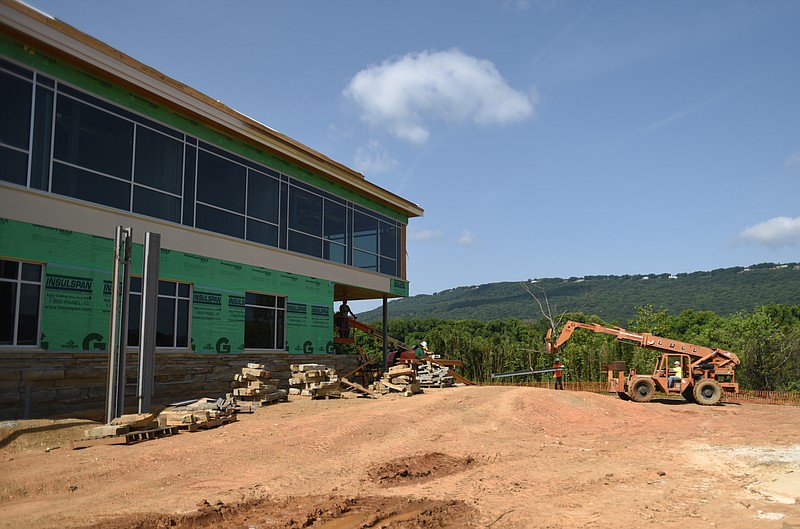Milestones
During Charlie Arant’s tenure as president and CEO of the Tennessee Aquarium, the institution marked several milestones.» IMAX 3-D Theater opened in 1996.» Conservation Institute established in 1996.» Aquarium’s education department regional outreach programs launched in 1997.» Education department accredited by Southern Association of Colleges and Schools (SACS) in 2001. (The aquarium remains the only zoo or aquarium accredited as a Special Purpose School.)» Ocean Journey, the aquarium’s second building, opened in 2005.» River Gorge Explorer launched in 2008.» Aquarium received the National Medal from the Institute of Museum and Library Services in 2009.» Permanent facility for the Tennessee Aquarium Conservation Institute on Baylor School’s campus announced in October 2015. Source: Tennessee Aquarium
For the last five years, the Tennessee Aquarium has been conducting freshwater research out of its basement. Now, upon completion of its newly constructed research facility, the aquarium is poised to become a leading science center in the Southeast.
At the edge of the construction site, Charlie Arant emerges from his SUV wearing buttercup-colored shirtsleeves, a hardhat and a grin. "They haven't let me out here since they laid me off," he jokes.
Last March, Arant retired as president and CEO of the Tennessee Aquarium. But before he did, he says, he made sure ground had been broken on the new Tennessee Aquarium Conservation Institute, a 14,000-square-foot riverfront facility which will serve as the largest freshwater research and education center in the Southeast.
The institute might also serve as the greatest legacy of Arant's 20-year career with the aquarium. His commitment to the project helped him win Conservationist of the Year during the Tennessee Wildlife Federation's 2016 Conservation Achievement Awards.
But Arant insists that compared to the aquarium's scientists, he is small fry.
"Their passion for these animals made me want to do more to help them. My job was to get them resources, and this [facility] is a resource. Once it opens, I think you will see the [Tennessee Aquarium] become a substantial contributor to not just Chattanooga but to the entire region," Arant says.
While the new institute is slated to open in early October, Get Out Chattanooga had the opportunity to tour the facility while it was still under construction. Here is what we learned about the institute's history, space and purpose.
The Tennessee Aquarium's science center, originally called the Southeast Aquatic Research Institute, was established in 1996 and based out of Cohutta, Georgia. In 2011, those operations were brought back to Chattanooga and moved into the aquarium's Broad Street building.
But, Arant says, that space is limited.
"Here, we have room to grow," Arant says as he steps inside the institute's spacious new structure, still wrapped with plastic sheeting.
The two-story facility is located on Baylor School's campus just off Signal Mountain Road. The section of property on which it sits, which includes a wetland and access to the river, will be leased to the aquarium through a 100-year contract.
The space will better support all the institute's current programs - for example, its lake sturgeon reintroduction program which began under Arant's direction in 2000 - as well as allow for new features such as a genetic testing laboratory.
THE LAYOUT
Main Floor
The first floor features an area for freshwater tanks where native species can be studied or spawned and raised for reintroduction projects - like that aforementioned lake sturgeon program, which has been one of the aquarium's largest and most successful freshwater projects.
"The sturgeon was pretty well extinct when we started," Arant says.
To date, the institute, with help from its many partners, has successfully raised and released over 140,000 lake sturgeon in the upper Tennessee River and over 40,000 lake sturgeon in the Cumberland River.
Similarly, in 2013, the institute's native-trout program spawned, raised and released 255 Southern Appalachian brook trout, a species that once teemed in high-elevation streams of the Southeastern U.S. but now occupies only 13 percent of its historical range.
Other ongoing aquarium projects include research of the red salamander, cave shrimp, coldwater darter, gopher tortoise and more.
Upon completion of the new building, aquarium scientists will also begin to study alligator snapping turtles, collecting DNA samples (i.e. toenail clippings) to help determine genetic variation among populations as well as the water quality of their habitat.
While the freshwater tanks will occupy most of the main floor, there will also be an equipment room for gear such as nets, seines and wetsuits, as well as a "growth area," which Arant explains is extra space available for future needs.
Upper Floor
The second floor includes the DNA laboratory (where those turtle toenails will be analyzed) and the morphology laboratory. Morphology refers to the study of an organism's structure, from its cells to its anatomy.
Previously, aquarium scientists have had to travel to off-site locations to analyze samples.
"Traveling adds complexity. Here, we'll be able to do it faster and cheaper," Arant says.
Across the hall from those labs there is office space, a conference room and classrooms, all surrounded with wall-to-wall windows that overlook the Tennessee River, as silvery and serpentine as the spine of a lake sturgeon.
This new structure, says Arant, will sustain more than just freshwater animals; it will also serve as an information hub. Those lab reports, research data and the biodiversity heat maps currently being generated by the aquarium's graphic information systems' analysts will all be uploaded onto the new facility's database, which will be able to be accessed by researchers anywhere.
"Right now all this information is in different places: a filing cabinet at a university; a computer at the U.S. Fish and Wildlife Service. We want to bring it all together in this place," Arant says.
The building itself will also accommodate the greater scientific community by having the space - including the dormitories and cafeteria on Baylor's campus - to host visiting scientists and students.
"What an amazing experience for a kid interested in freshwater animals to come out here and work alongside scientists," Arant says, adding that growing up, he was not an outdoorsy child. He says he did not develop a passion for the natural world until he began his career with the Tennessee Aquarium.
"Now my grandkids have grown up in the [Tennessee Aquarium]. Their eyes have already been opened to all these possibilities," he says. That, he continues, is the mission of the Tennessee Aquarium: to nurture an appreciation for what lives in the river.
And the role of the institute is to preserve and protect those species.
"This facility is our renewed commitment to the river," Arant says, adding wistfully, "I say 'our' like I'm still with the aquarium."

